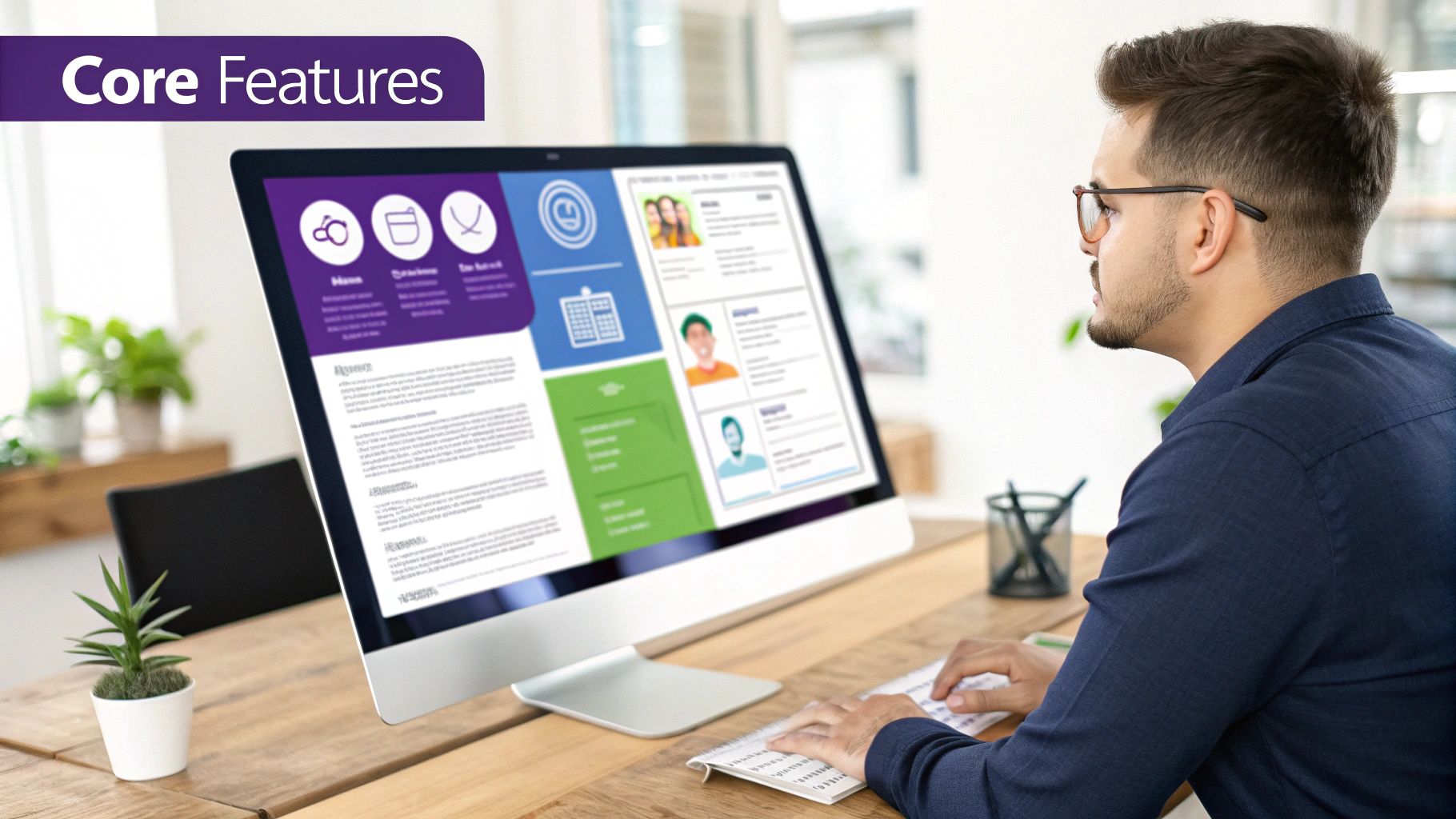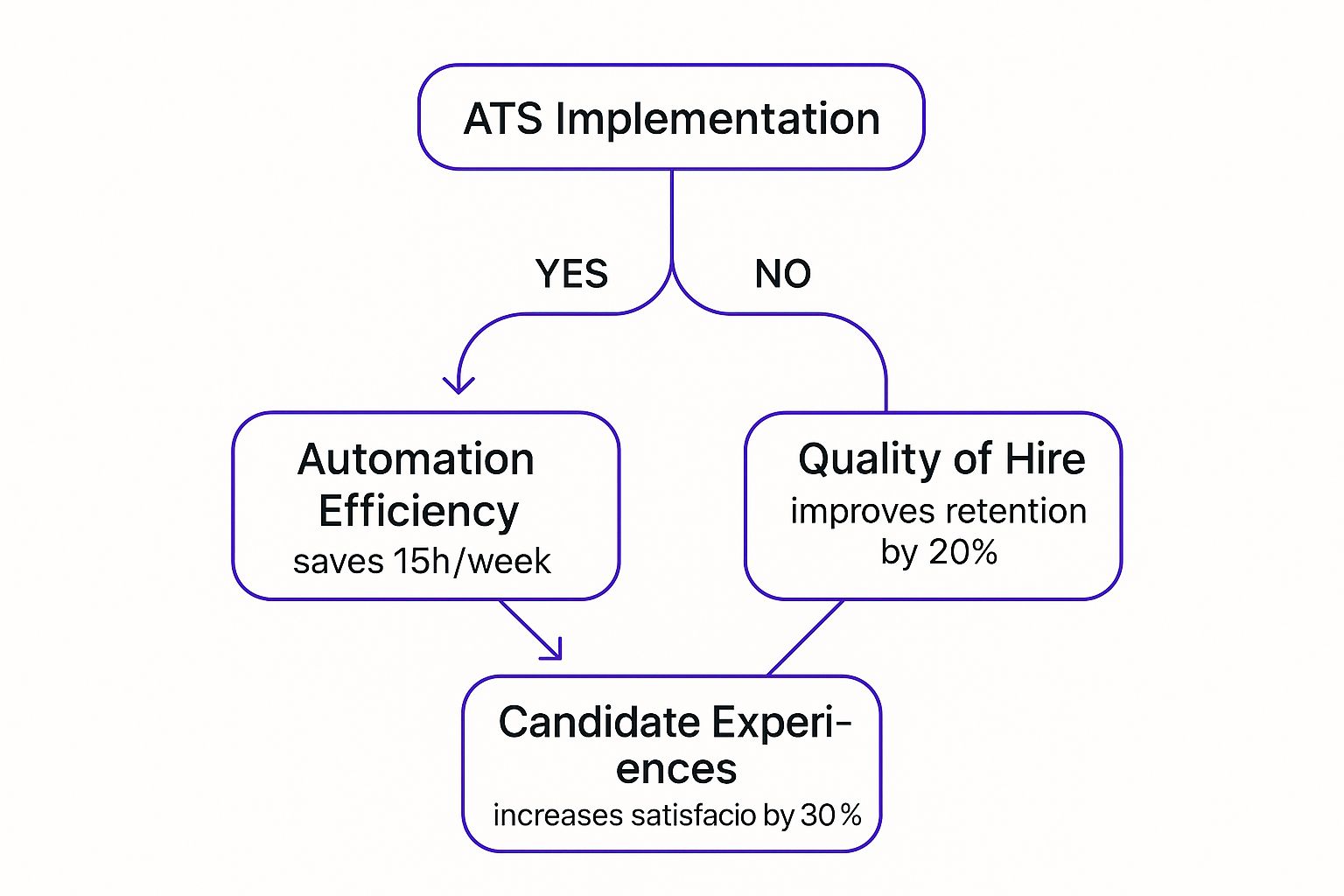A Guide to Job Application Tracking System Software
Ever sent a resume into the digital void, wondering if anyone actually saw it? You're not alone. The silent gatekeeper in this process is often a job application tracking system, or ATS.
Think of it as a bouncer for a massive club—the club being a company's applicant pool. Its job is to manage the line, check IDs, and make sure the right people get in front of the hiring manager. This digital filter is why a staggering 98.4% of Fortune 500 companies rely on an ATS to handle the sheer volume of applications.
Unpacking Your Digital First Impression

Picture a recruiter trying to fill one popular role. They might get hundreds, maybe even thousands, of applications. Trying to read every single one is a recipe for burnout. This is exactly where a job application tracking system steps in to save the day. It replaces cluttered inboxes and chaotic spreadsheets with a single, organized dashboard for the entire hiring journey.
At its heart, an ATS is a sophisticated database. When you hit "submit" on your application, your resume isn't just dropped into an email. It's uploaded, parsed, and neatly filed away into a structured candidate profile.
How an ATS Parses and Organizes Information
The magic of an ATS lies in its ability to take an unstructured document (your resume) and turn it into searchable, structured data. It reads through your application and pulls out the important bits.
This process involves identifying and tagging key details like:
- Contact Information: Your name, email, phone number, and location.
- Work Experience: Past employers, job titles, and dates of employment.
- Education: Your degrees, schools, and graduation dates.
- Skills: Specific keywords from the job description, like software proficiency or certifications.
This automated sorting is a game-changer for recruiters. They can instantly search for "project management" and "PMP certification" to pull up a shortlist of qualified candidates. It saves them countless hours of manually scanning resumes.
More Than Just a Digital Filing Cabinet
But an ATS is much more than a simple resume sorter. Modern systems are powerful tools that manage the entire hiring workflow. They track every candidate's progress—from the initial application, through screenings and interviews, all the way to the final job offer.
The goal is not to replace human recruiters but to empower them. An effective ATS handles the repetitive, administrative tasks, freeing up hiring teams to focus on what truly matters: engaging with and evaluating the best candidates.
Ultimately, it all comes down to efficiency. For anyone who wants to get their hands dirty and see how it works from the inside, you can explore a job application tracking template to understand the logic behind these platforms.
By automating the heavy lifting of data collection and initial screening, these systems make the hiring process strategic and manageable. They ensure no great candidate slips through the cracks and help teams make smarter, faster decisions, which is a key part of streamlining the hiring process with an Applicant Tracking System.
A Look Under the Hood: Core Features of Modern Recruitment Software

To really get what a job application tracking system is all about, you need to peek under the hood at the features that make it tick. These aren’t just glorified spreadsheets; they're smart platforms built to crush the most tedious parts of hiring. Think of it as a recruiter’s digital command center, with every tool designed to fix a specific headache in the hiring process.
It all starts with intelligent resume parsing. When you upload your resume, the system does more than just save the file. It reads, understands, and sorts all that information, automatically creating a clean candidate profile with your contact info, work history, skills, and education.
This single feature turns a simple document into a goldmine of searchable data, saving hiring teams from countless hours of mind-numbing data entry.
Keeping Candidates and Communication in Check
Once a profile is created, the system's true organizational magic begins. Recruiters build custom pipelines—think of a Trello board for hiring—with stages like "Applied," "Screening," "Interview," and "Offer." They can drag and drop candidates between stages, giving them a bird's-eye view of the entire talent pool.
Organization is great, but modern systems really shine when it comes to communication. Automated messaging is the secret sauce for a good candidate experience.
- Instant Acknowledgements: The system immediately sends a "we got it!" email, so you know your application didn't vanish into the void.
- Status Updates: You get automatic pings when you move to the next stage or if the role is filled. No more application "black hole."
- Easy Interview Scheduling: Instead of endless email tag, the system syncs with calendars and lets you pick an interview slot that works for you.
These simple, automated touchpoints make sure no one is left guessing, which goes a long way in protecting a company's reputation.
A job application tracking system is like the central nervous system for a company's hiring. It connects all the different tasks—parsing, filtering, scheduling, and communicating—into one smooth workflow, giving recruiters their most precious resource back: time.
This demand for smarter hiring is why the applicant tracking system market is booming, projected to jump from $3.28 billion in 2025 to a massive $4.88 billion by 2030. Companies everywhere are realizing they need better tools to find and engage top talent.
Advanced Filtering and Team-Based Hiring
Beyond just keeping things tidy, a modern tracking system has some serious search power. Let’s say a recruiter needs a software engineer. They can instantly sift through thousands of applications to find candidates who know "Python" and have an "AWS certification." This turns a giant database into a perfectly targeted shortlist in seconds.
And hiring is almost never a one-person show. These platforms are built for teamwork. Recruiters, hiring managers, and interviewers can all jump into a candidate's profile to leave private notes, rate them with scorecards, and share feedback.
Everything is centralized, so the whole team is on the same page. This is also where a personal job application tracking system can be a game-changer for you, the applicant. By using a job tracker, you can mirror this organized approach, keeping tabs on your applications and communications so you're always ready for what's next.
The Real-World Benefits of an Integrated ATS
Putting a job application tracking system in place does way more than just tidy up your resume pile—it completely overhauls how a company finds and hires people. The positive effects spread throughout the entire organization, influencing everything from team productivity to your company’s reputation. Let's break down the tangible results into four key areas.
The first thing you'll notice is a massive jump in efficiency. Recruiters get bogged down in administrative quicksand: manual data entry, weeding out unqualified applicants, and the endless email chains of scheduling interviews. An ATS automates all that repetitive work, freeing up your team to do the human stuff—like actually talking to top candidates and making smart hiring calls.
Think about it. Instead of drowning in hundreds of emails, a recruiter can instantly filter for must-have skills and pull together a qualified shortlist in minutes. That simple shift can give them back a huge chunk of their workweek.
Elevating the Quality of Every Hire
But saving time is only part of the equation. A job application tracking system also equips your team to make smarter, data-backed hiring decisions. It removes the guesswork and helps sidestep unconscious bias by standardizing the entire evaluation process with tools like collaborative scorecards and centralized feedback.
Hiring managers and interviewers can all log their notes and rate candidates against the same set of criteria. Everyone's on the same page. This team-based approach leads to way more objective decisions and a much higher quality of hire. You end up with people who aren't just qualified on paper but are a fantastic long-term fit for the team.
This decision tree illustrates how implementing an ATS directly leads to better business outcomes, from saving precious time to improving employee retention.

As you can see, there's a clear line connecting the use of an ATS to real, measurable wins in efficiency, retention, and how candidates feel about your company.
Enhancing the Candidate Experience
Let’s be honest: your hiring process is often the very first real interaction someone has with your brand. A clunky, confusing, or totally silent application experience can sour your company’s reputation and scare away great talent for good.
An integrated ATS turns that potential pitfall into a positive moment for your brand.
- Automated Communication: It instantly confirms when an application is received and sends out timely status updates. No more "application black hole."
- Seamless Scheduling: Candidates can easily pick an interview time that actually works for them, cutting out all the frustrating email tennis.
- Professional Interface: It provides a clean, branded careers page that makes the whole process simple and professional.
These touches make every applicant feel seen and respected, no matter the outcome. And while companies use an ATS to manage their pipeline, job seekers can get the same edge by using a dedicated job search organizer to track their own applications and follow-ups.
A great candidate experience isn't just a nice-to-have; it's a competitive advantage. An ATS ensures that even the people you don't hire walk away with a good impression, and they might just become customers or reapply down the road.
Finally, an ATS is your best friend when it comes to staying compliant and managing risk. It automatically creates a standardized, documented record of every hiring decision. This is crucial for proving fair hiring practices and sticking to equal opportunity employment laws. By keeping clean records, the system protects your organization and makes sure every step of your recruitment process is transparent and easy to defend.
How to Choose the Right ATS for Your Business

Picking an ATS is a huge deal. It’s a decision that directly impacts your ability to find and hire the people who will build your company. But let's be clear: the "best" platform isn't the one with the most bells and whistles. It's the one that actually solves your team's biggest recruiting headaches.
What works for a scrappy startup scaling up will be a terrible fit for a massive global corporation, and vice versa.
So, where do you start? With a simple audit of your current hiring process. Get honest about where things are breaking. Are you losing amazing candidates because it takes a week just to schedule the first call? Is your recruiting team buried in spreadsheets and manual data entry?
Nailing down these pain points creates your shopping list—the non-negotiable problems your new ATS absolutely has to fix.
Defining Your Non-Negotiable Features
Once you know what’s broken, you can build a list of must-have features. It’s easy to get distracted by flashy demos and cool add-ons, but stay focused on the core functions that will make a real difference.
For most businesses, the list boils down to a few essentials:
- An Interface People Actually Want to Use: If your hiring managers think the system is a clunky, confusing mess, they just won't use it. It has to be intuitive for everyone involved, from recruiters to the C-suite.
- Plays Well with Others: Your new ATS must connect seamlessly with the tools you already use, like your HRIS and payroll software. Look for pre-built integrations to avoid expensive, custom-coded nightmares down the road.
- Room to Grow: Pick a system that can grow with you. A platform that's perfect for hiring 10 people this year should be able to handle 100 next year without falling apart.
Think of it like buying a car. A two-seater sports car looks fun, but if you have a big family and need to haul gear, an SUV is the only practical choice. Your ATS selection needs to be just as pragmatic.
Matching the System to Your Business Size
The needs of a small business and a global enterprise are worlds apart, and the ATS market knows it. Startups and smaller companies are usually looking for simplicity, speed, and a price tag that won’t make their CFO cringe. They need a tool they can set up in a weekend without a dedicated IT team.
Large corporations, on the other hand, are hunting for a powerhouse. They need robust systems that can handle complex multi-stage approvals, airtight security protocols, and deep compliance reporting. For them, a proven track record is everything.
In the corporate world, brand recognition is a big factor. An analysis of over 12,000 companies shows a pretty distributed market share between platforms like Greenhouse, Lever, and Workday. But when you zoom in on just the Fortune 500, Workday alone owns over 39% of the market. You can discover more insights about ATS market share on Jobscan.co.
This data shows how big companies tend to stick with the established players known for their reliability and all-encompassing features. To make the choice clearer, here’s a quick breakdown of what matters most based on your company's size.
ATS Selection Criteria by Business Size
| Selection Factor | Small & Medium Business (SMB) Focus | Large Enterprise Focus |
|---|---|---|
| Budget | Predictable, all-in-one monthly subscriptions with low setup fees. | Custom pricing based on high user counts and advanced modules. |
| Key Features | Job posting, resume parsing, and basic candidate communication tools. | Advanced analytics, multi-level approval workflows, and compliance management. |
| Integration | Standard integrations with common tools like Slack and Google Calendar. | Deep integration with complex HRIS, ERP, and onboarding systems. |
| Implementation | Quick, do-it-yourself setup that can be completed in a few days. | A lengthy, guided implementation process that may take several months. |
Ultimately, the goal is to find a system that aligns with how your business actually operates today—and how you plan to operate tomorrow.
And hey, if you're an individual just trying to manage your own job search, a personal job application tracking system can bring that same sense of order to the chaos. Check out our guide on using a job application tracker to see how these same principles can help you land your next role.
What's Next for Recruitment and Application Tracking?
The world of hiring tech never sits still, and the humble application tracking system is right in the middle of a massive glow-up. What used to be little more than a digital filing cabinet is evolving into a smart, predictive hub that’s completely changing how companies find and hire people. The next wave of these platforms is about to redefine the game.
The biggest driver of this change? Artificial Intelligence (AI). We're blowing past simple keyword searching and diving headfirst into predictive analytics. The ATS of tomorrow won’t just tell you who is qualified; it will help predict who will actually succeed in the role.
By chewing on data from past successful hires, AI can spot hidden patterns in the skills and experiences that lead to great performance. This data-first approach helps strip away unconscious bias, pushing hiring teams to focus on a candidate's real potential instead of just a gut feeling.
The Shift to Mobile and Connected Systems
Another huge change is the all-out sprint toward mobile-first platforms. Recruiters and candidates are constantly on the move, and they expect their tools to keep up. A modern ATS has to work flawlessly on any device, whether it's a manager swiping through résumés on their phone or a candidate applying for a job with just a couple of taps.
Let's be clear: this isn't a "nice-to-have" feature anymore. It's a dealbreaker. If your application process is clunky on a smartphone, you're waving goodbye to a huge chunk of potential talent.
Beyond just going mobile, the future is all about integration. Standalone software is on its way out. The best systems are becoming the central nervous system for HR, connecting to all sorts of other tools through open APIs.
This means your ATS can finally talk to your other software, creating a powerful, custom-built HR machine. Imagine it communicating seamlessly with:
- Onboarding Software: To instantly turn a candidate into a new hire.
- HRIS Platforms: To keep all your employee data perfectly in sync.
- Background Check Services: To kick off a screening with a single click.
The next chapter for hiring tech is all about creating an experience that's connected, intelligent, and dead simple for everyone. It’s about using technology to build hiring processes that are smarter, faster, and a whole lot fairer.
Cloud Power and Predictive Insights
What’s making all this possible? The unstoppable rise of cloud-based software. The cloud is easily the fastest-growing part of the industry, making up almost 58% of the entire ATS market share in 2024. Companies need flexibility, and the cloud delivers. The IT and telecom sector alone makes up 26% of that market, a testament to how crucial this tech has become. If you want to dig deeper, you can review the market analysis on gminsights.com.
As we watch AI reshape hiring, it's also worth thinking about the projected impact of AI on the job market itself. These shifts directly influence what we need from our recruiting tools. Application tracking systems aren't just reacting to these changes—they’re at the forefront, turning data into the most valuable asset in any company's talent strategy.
Got Questions About Job Application Tracking Systems? We've Got Answers.
Even after you get the gist of what a job application tracking system is, the practical questions always start to bubble up. This happens whether you're a job seeker trying to get your resume seen or a company trying to pick the right software.
Let's clear the air and tackle some of the most common questions we hear. We'll cover everything from getting your resume past the bots to what you can realistically expect to pay.
How Do I Get My Resume Past an ATS?
This is the big one for job seekers, and for good reason. Before a human ever sees your application, you have to get past the initial digital gatekeeper. The goal isn't to "trick" the system, but to make it easy for the software to read your resume and understand why you're a great fit.
Think of an ATS as a very literal-minded librarian. If your resume is like a book with a clear title, organized chapters, and standard text, the librarian can easily find it and put it on the right shelf. But if it's full of weird fonts, confusing tables, and artsy graphics, it gets lost in the stacks.
Here are a few simple rules that make a huge difference:
- Speak Their Language: Look closely at the job description. If it asks for a "Social Media Strategist" with "experience in content creation," your resume should include those exact phrases. Mirroring the language is the most effective thing you can do.
- Keep It Clean and Simple: Fancy formatting is your enemy here. Stick to a clean, single-column layout with standard fonts like Arial, Helvetica, or Calibri. Avoid tables, columns, headers, and footers. Use standard section titles like "Professional Experience" and "Education."
- Stick to Standard File Types: Unless the application says otherwise, always submit your resume as a Word doc (.docx) or a text-based PDF. Some systems can't properly read image-based PDFs or other less common file types, meaning your info gets scrambled or ignored completely.
Follow these tips, and you'll make it incredibly easy for the job application tracking system to see your qualifications and move you to the top of the pile.
What's the Real Cost of an ATS?
For any business, this is usually the first question that comes up. The price tag on an ATS can swing wildly depending on how big your company is, how many people you're hiring, and what specific features you need. There’s no one-size-fits-all answer, but the pricing usually fits into a few buckets.
Most ATS providers run on a subscription model, billed monthly or annually. The final price is usually tied to one of these things:
- Per Recruiter/User: You pay a fee for every person on your team who needs to log in. This is a popular model for small and medium-sized businesses.
- Per Company Employee: The cost is based on the total number of employees at your company. This is more common for larger, enterprise-level clients.
- Per Open Job: Some platforms charge you based on how many active jobs you're trying to fill at any given time.
For a small business, entry-level plans might start around $50 to $100 per month. Mid-sized companies often land in the $100 to $500 monthly range. For large corporations needing all the bells and whistles, like custom integrations and advanced analytics, the cost can easily jump into the thousands each month.
Don't forget to ask about hidden costs! The subscription fee might not be the whole story. Always check for one-time setup fees, data migration costs, or extra charges for training and support.
How Long Does It Take to Set Up an ATS?
Getting a new job application tracking system up and running can take a weekend or a few months—it all depends on the software's complexity and how prepared your team is.
If you're a small startup grabbing a simple, ready-to-go cloud tool, you could genuinely be set up in a day or two. But for a large company with legacy systems and complex workflows, it's a much bigger project.
Here’s a rough timeline to give you an idea:
- Basic Setup (1-7 Days): Perfect for small teams using a simple, out-of-the-box system. This usually just involves creating accounts, adding your company branding, and setting up a few job templates.
- Standard Implementation (2-6 Weeks): This is common for mid-sized businesses that need to move over an existing candidate database or connect the ATS to other tools like Slack or Google Calendar.
- Enterprise Rollout (2-6 Months): This is for large organizations that need the ATS to deeply integrate with their core HR and payroll systems. This timeline includes custom configurations and extensive training for different departments.
A little planning goes a long way. The smoothest transitions happen when a company knows exactly what its internal processes are and what data needs to be moved before they sign on the dotted line. A bit of prep work upfront can save you a ton of headaches down the road.
Ready to take control of your job search with a powerful, AI-driven platform? Eztrackr helps you manage every application, craft perfect resumes, and track your progress all in one place. Over 45,000 job seekers trust our tools to stay organized and land their dream job faster. Start streamlining your job hunt with Eztrackr today!
 Interview Sidekick
Interview Sidekick